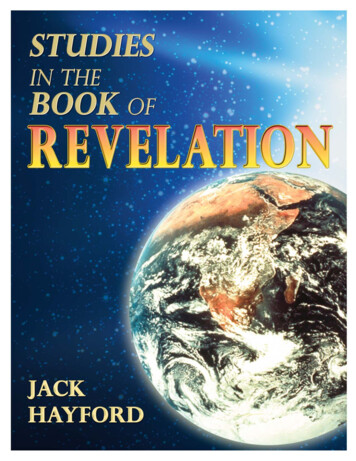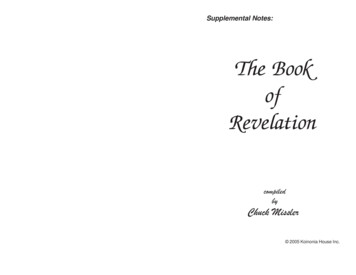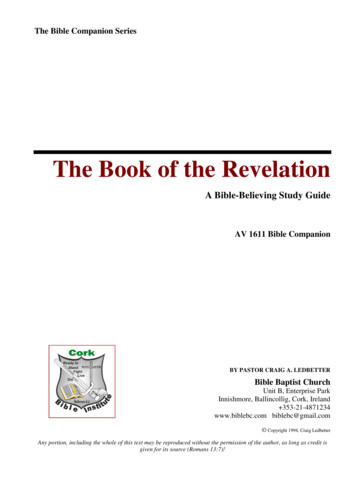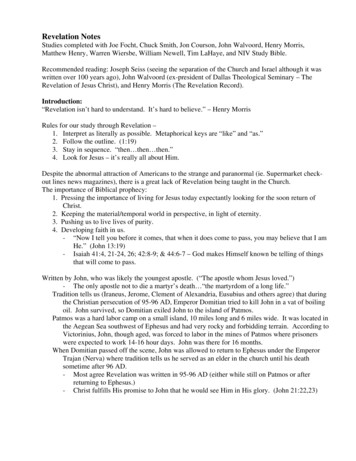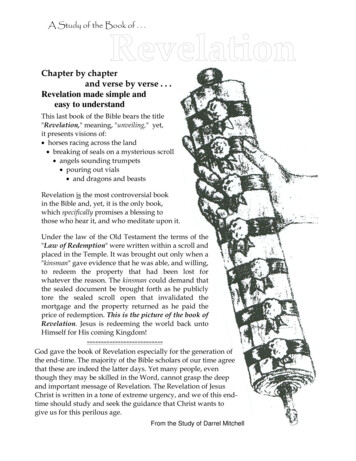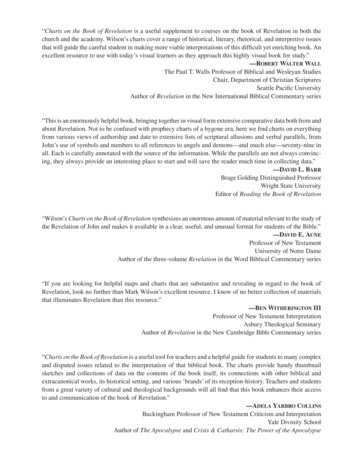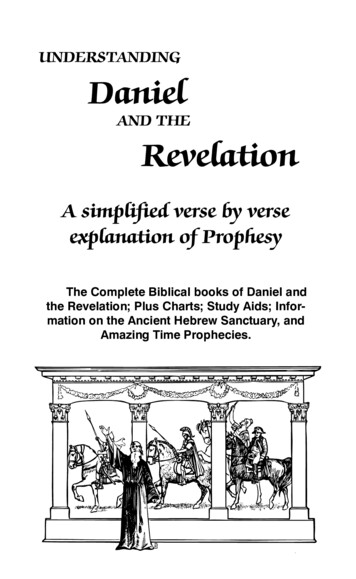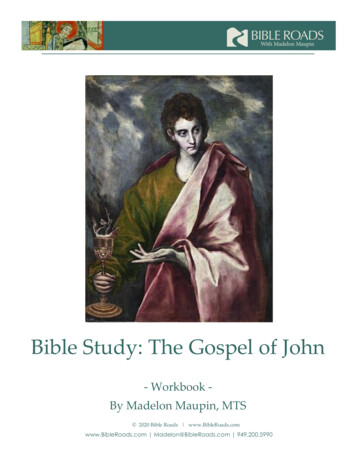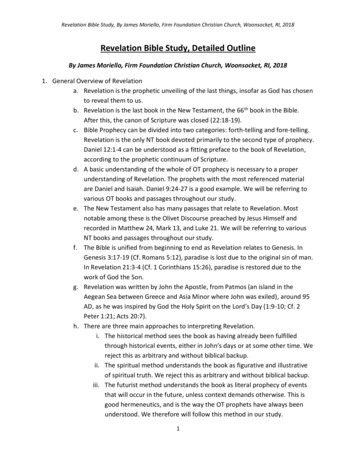
Transcription
Revelation Bible Study, By James Moriello, Firm Foundation Christian Church, Woonsocket, RI, 2018Revelation Bible Study, Detailed OutlineBy James Moriello, Firm Foundation Christian Church, Woonsocket, RI, 20181. General Overview of Revelationa. Revelation is the prophetic unveiling of the last things, insofar as God has chosento reveal them to us.b. Revelation is the last book in the New Testament, the 66th book in the Bible.After this, the canon of Scripture was closed (22:18-19).c. Bible Prophecy can be divided into two categories: forth-telling and fore-telling.Revelation is the only NT book devoted primarily to the second type of prophecy.Daniel 12:1-4 can be understood as a fitting preface to the book of Revelation,according to the prophetic continuum of Scripture.d. A basic understanding of the whole of OT prophecy is necessary to a properunderstanding of Revelation. The prophets with the most referenced materialare Daniel and Isaiah. Daniel 9:24-27 is a good example. We will be referring tovarious OT books and passages throughout our study.e. The New Testament also has many passages that relate to Revelation. Mostnotable among these is the Olivet Discourse preached by Jesus Himself andrecorded in Matthew 24, Mark 13, and Luke 21. We will be referring to variousNT books and passages throughout our study.f. The Bible is unified from beginning to end as Revelation relates to Genesis. InGenesis 3:17-19 (Cf. Romans 5:12), paradise is lost due to the original sin of man.In Revelation 21:3-4 (Cf. 1 Corinthians 15:26), paradise is restored due to thework of God the Son.g. Revelation was written by John the Apostle, from Patmos (an island in theAegean Sea between Greece and Asia Minor where John was exiled), around 95AD, as he was inspired by God the Holy Spirit on the Lord’s Day (1:9-10; Cf. 2Peter 1:21; Acts 20:7).h. There are three main approaches to interpreting Revelation.i. The historical method sees the book as having already been fulfilledthrough historical events, either in John’s days or at some other time. Wereject this as arbitrary and without biblical backup.ii. The spiritual method understands the book as figurative and illustrativeof spiritual truth. We reject this as arbitrary and without biblical backup.iii. The futurist method understands the book as literal prophecy of eventsthat will occur in the future, unless context demands otherwise. This isgood hermeneutics, and is the way the OT prophets have always beenunderstood. We therefore will follow this method in our study.1
Revelation Bible Study, By James Moriello, Firm Foundation Christian Church, Woonsocket, RI, 20182. 1:1-3, Introduction and Benedictiona. 1:1, the most fitting title would be “The Revelation of Jesus Christ”, revealed byGod the Father through God the Son by God the Holy Spirit to John the Apostleb. 1:3, special blessing promised for reading and obeying this prophecy, whichcannot be fully received unless one understands its applications, Revelation waswritten to the NT church and is not to be ignoredc. “time is near”, that of the end, the Day of the Lord, timing is given from God’sperspective, that of One who exists outside of timei. Warnings against date setting, Matthew 24:36; Acts 1:7ii. Second Coming is approaching, Hebrews 10:25iii. 2 Peter 3:8 makes our point of God operating on His own timetable, butcannot be used for any kind of date setting or equivalency, as this is notits intent in the passage, and one would have to apply both day to yearsand years to day (which Scripture does not support)iv. Parable of the fig tree cannot be used to date set based on Israel’sreconstitution as a sovereign state in the last several decades1. Matthew 24:32-35; Luke 21:29-33, Luke passage “and all thetrees” shows the reference to be to trees in general, and “thisgeneration” is that which is alive in Tribulation days3. 1:4-8, Greeting to the Seven Churchesa. 1:4, “seven churches” (1:11), circular letter to the seven churches in Asia Minor,note their location relative to Patmos on a mapb. “is was is to come”, emphasizing the past, present, and future ministry ofChrist, and His attribute of eternality (John 1:2)c. “seven spirits”, in light of Revelation 3:1, these are interpreted as those whichare found in Isaiah 11:2 (Holy Spirit, wisdom, understanding, counsel, might,knowledge, fear of the LORD)d. 1:5, “faithful witness”, John 5:36-37e. “firstborn from the dead”, His resurrection the basis for our hope; Christ our‘first fruits’ (1 Corinthians 15:20-28)f. “His own blood” the propitiation for our sins (Romans 3:25)g. 1:6, royal priesthood by spiritual adoption (1 Peter 2:5; Romans 8:14-17)h. 1:7, “coming with the clouds” (Acts 1:9-11), place of Jesus’ Second Coming willbe Bozrah in Edom (Isaiah 34:1-7, 63:1-6; Habakkuk 3:3; Micah 2:12-13)i. Literal fulfillment of Zechariah 12:10 is affirmed in this verse alsoj. 1:8, four names of Christ, “I am”, “Alpha and the Omega”, “Beginning and theEnd”, “Almighty”2
Revelation Bible Study, By James Moriello, Firm Foundation Christian Church, Woonsocket, RI, 20184. 1:9-11, The Things John Saw, Introductiona. 1:9, “John the Apostle”, “companion in the tribulation” which Christiansexperienced under the Emperor Domitian (date of writing, 95 AD)b. See notes in the introduction, 1gc. 1:11, “write in a book and send it to the seven churches” via circular letter, ofthe entire Book of Revelation, with an individual letter to each church included5. 1:12-20, The Vision of the Glorified Jesus Christa. 1:12, “seven golden lampstands” are “the seven churches” listed in verse 11,Revelation self-interprets in 1:20b. 1:13, “like the Son of Man”, Cf. Daniel 7:13-14c. The garments indicative of Jesus’ present work in the church age as glorifiedHigh Priest and Mediator (Exodus 28:4; Hebrews 7:25-26; 1 Timothy 2:5)d. 1:13-15, compare with visions of God in Daniel 7:9-10, Isaiah 6, Ezekiel 1e. 1:16,20, “seven stars are the angels of the seven churches” to whom the lettersof Revelation 2 and 3 are written, the term allows for literal angels, but a logicalunderstanding of the meaning of the word is that of a human messenger (2:1),which is the opinion of this authorf. 1:17-18, “Do not be afraid”, Christians need not fear, for death has no dominionover the believer, as the eternal God has conquered it (1 Corinthians 15:55-57)g. 1:19, the threefold division of the Book of Revelation (broad outline)i. Chapter 1, “the things which you have seen”ii. Chapters 2-3, “the things which are”iii. Chapters 4-22, “the things which will take place after this”h. 1:20, the churches listed in 1:11, and their messengers, prefacing the next 2chapters (2-3), which we will observe using the following frameworki. Actual historic churches existing in that dayii. Prevailing conditions in those actual historic churchesiii. The way in which the prevailing conditions of these churches form anoutline of church historyiv. Characteristics of actual churches todayv. Characteristics of individual believers today3
Revelation Bible Study, By James Moriello, Firm Foundation Christian Church, Woonsocket, RI, 20186. Self-Test: Reinforcing what you have learned so far, Intro and Revelation 1a. What are the two general categories of Bible prophecy?b. Which Scripture(s) forbid setting a date for the end time?c. Genesis is paradise lost. Revelation is paradise .d. Which chapter in Matthew correlates the most with the Book of Revelation, inthat it has much teaching by Jesus about end times?e. Who wrote Revelation, and approximately what year did he write it?f. What attributes of Jesus Christ are emphasized in Revelation 1?g. What are the “seven spirits”?h. What are the “seven stars”?i.What are the “seven lampstands”?j.Describe two things about the appearance of the Glorified Christ?k. How and where will Jesus return in His Second Coming?l.True or False: An understanding of the Old Testament prophets is essential to aproper deep understanding of Revelation.m. What are two Old Testament Books that have many cross references with theBook of Revelation?4
Revelation Bible Study, By James Moriello, Firm Foundation Christian Church, Woonsocket, RI, 20187. 2:1-7, Ephesus, The Church that Lost its First Lovea. The City and its Historyi. Located on the Aegean Sea in Asia Minor (view on map)ii. Since its founding about 1000 BC, devoted to fertility goddess worshipiii. In NT days, devoted to Artemis (Diana) worship (Acts 19:35)iv. Temple of Artemis of the Ephesians one of the Seven Wonders of theAncient World (163x342x60 feet)v. Paul instrumental in the founding of the church there, late in his SecondMissionary Journey (Acts 18:19-20)vi. Paul returned there on his Third Missionary Journey, and spent well overtwo years in Ephesus (Acts 19:8-10)vii. Timothy became the leading teaching elder in Ephesus, a role delegatedto him by Paul (1 Timothy 1:3)viii. According to tradition, John the Apostle served as overseer of all sevenchurches in Revelation 2-3, based in Ephesus; one tradition is that hereturned there from Patmos and died there (his tomb? Is there today)ix. The description of this church fits the historical era from 30 AD-100 AD,often known as the Apostolic Era.b. Exposition of the passagei. 2:1, “to the angel write”, probably a human messenger appointed to thetask, but it is possible an actual angel took human form for the task(Galatians 3:19 is likewise disputed on the same grounds)ii. “stars lampstands” are identified in Revelation 1:20iii. 2:2-3, commendations1. Works of God2. Patience through tribulation3. Sound doctrine4. Spiritually discerning and rejecting of unsound doctrine5. Persevering in the faith, in the general senseiv. 2:4, the reproof, that the love of the church had grown cold, andbacksliding and going through the motions were now evidentv. 2:5, the divine advice, repentance1. “do the first works” according to the love and in the spirit theywere done at the first2. “remove your lampstand”, Matthew 5:13-16, a church thatcontinues in a loveless state is of no use to Christ, one reason whysome (not all) churches close is that God closes them as a finalmeans of discipline when all other warnings fail5
Revelation Bible Study, By James Moriello, Firm Foundation Christian Church, Woonsocket, RI, 2018vi. 2:6, “Nicolaitans”1. Some: a party of those who follow one named Nicolas, doubtful2. Etymology: “niko laos”, meaning “conquerors of the laity”,through ecclesiastical authority and/or extrabiblical priesthoodcreated for power and resulting in evil deedsvii. 2:7, Promise to those who overcome1. Overcomers, 1 John 5:1-52. Temptation to wax cold in faith due to spiritual weariness must beovercome, lest you join the ranks of the “has beens” who used todo this and that but one wonders if they are saved at all!3. “tree of life”, Genesis 3:22-24; Revelation 22:1-5c. Applications for the local churchi. Is the church membership truly saved?ii. Does the church go through the motions in some areas?iii. Is the church outwardly or inwardly focused?iv. Has the church doctrine held firm to Scripture?v. Does the church tolerate false doctrine?vi. Does the church worship and minister with less zeal than in times past?(Note: By worship, I do not mean congregational singing only, but allother areas of worship like prayer and prioritizing time to hear God’sWord read and expounded)d. Applications for selfi. Same as the 6 points above, but substitute “the church” with your name(Note: I did not say someone else’s name)ii. It’s time for our churches and selves to get repentant and get revived!This starts with you. If you are prioritizing a study like this one, and areserious about putting the things you learn into practice, then you arebeing called to be an example of personal revival!8. 2:8-11, Smyrna, The Persecuted Churcha. The City and its Historyi. Etymology unknown, possibly from semitic “smurnah”, from “myrrh”ii. Located by the Aegean Sea, 40 miles north of Ephesusiii. Modern day city of Izmir, Turkey, population 1.5 millioniv. Hellenized city, built up in the days of Alexander the Great, worshiped thegod Roma, pandering to Rome in order to sever itself from Pergamum’spowerv. Rich and prosperous trade city in the ancient world, but the early churchdid not share in this, being marginalized socially by Jews and Gentiles6
Revelation Bible Study, By James Moriello, Firm Foundation Christian Church, Woonsocket, RI, 2018alike, and economically by the trade guilds (Cf. Acts 19:24-25) and localcivil authorities, with the approval of Romevi. Polycarp ministered in Smyrna and was martyred there, around 156 AD,being boiled in oil and burned at the stakevii. The description of this church fits the historical era from 100-313 AD.b. Exposition of the Passagei. 2:8, the eternal and risen Christ1. He “was dead” and “came to life”, giving hope to the Christianmartyr (1 Corinthians 15:20-22)ii. 2:9, “your works”, in context these were enduring (1 Corinthians 3:11-14)iii. “tribulation”, the empathy of Jesus, who bears with us and bears usthrough the trials, Cf. Psalm 23iv. “poverty (but you are rich)”, materially poor but spiritually rich, shut outof trade guilds but not shut out of heavenv. False profession of those “Jews” whose works did not bear out the faith,even that of orthodox nature (Romans 2:28-29)vi. “synagogue of Satan”, God has His church and Satan has his, where Godestablishes the genuine based on truth, Satan establishes the counterfeitbased upon liesvii. 2:10, “Do not fear ” (Matthew 10:16-28 fulfilled and applied)viii. Those who persecute God’s elect are knowingly or unknowingly doing thebidding of the “devil”ix. “tribulation ten days”, a reference to a localized situation in that day ofintense persecution and/or a prophecy regarding the ten periods ofintense persecution between 100 and 313 AD, culminating in that underthe Emperor Diocletianx. “crown of life”, a spiritual crown; crowns in the NT:1. Ibid, James 1:122. “Imperishable Crown”, 1 Corinthians 9:253. “Crown of Righteousness”, 2 Timothy 4:84. “Crown of Glory”, 1 Peter 5:45. All cast at the feet of Jesus, Revelation 4:10xi. 2:11, the promise of eternal security of the saints (1 John 5:1-5)1. Exercise: Where else is this doctrine affirmed in the Bible?c. Discuss: Is the American church today the opposite of the Smyrna church, in thatit is materially rich but spiritually poor? Does this describe you individually?What would you do in the face of intense persecution, and how do you know?7
Revelation Bible Study, By James Moriello, Firm Foundation Christian Church, Woonsocket, RI, 20189. 2:12-17, Pergamos, The Compromising Churcha. The City and its Historyi. Aka, Pergamon, Pergamumii. 60 miles north of Smyrnaiii. Hellenized center of pagan cults (notably, Zeus), emperor worshipiv. The description of this church fits the historical era from 313-600 AD,which was characterized by marriage of church and state. The name ofthe city actually means “thoroughly married.”1. Constantine: “In this sign conquer”, The Roman Empire mergedwith/morphed into the Roman Catholic (Universal Church)2. Pagan Practices Introduced: Includes Mary worship, Purgatoryv. Apply and Discuss: result of state sponsored religion is alwayscompromise with the culture, and often tyranny (hence the FoundingFathers’ clause against establishment of a state church.b. Exposition of the Passagei. 2:12, “sharp two edged sword”, Cf. 1:16; Hebrews 4:12ii. 2:13, “Satan’s throne”, seat of idolatry in Asia Minor in that dayiii. “hold fast did not deny My faith” despite being in the midst of evil andidolatryiv. “Antipas”, according to tradition, ordained by John the Apostle as Bishopof Pergamosv. 2:14, “doctrine of Balaam”, Cf. Numbers 22-24, inimical to Israel, “Balak”ordered Israel cursed in opposition to Genesis 12:1-3, this church wasapparently anti-Semitic, instead of honoring Israel as the guardians of theScriptures which ultimately led to our salvation (Romans 3:2)vi. Licentious in violation of Acts 15:20 and the greater law of Christian lovevii. 2:15, “doctrine of the Nicolaitans”, see notes on 2:6viii. 2:16, the action of God is often very sudden when we refuse to repent ofour sin once it becomes clearly known to usix. 2:17, “hidden manna”, sustenance supplied by God, which is hidden tothe world, Cf. Exodus 16; John 6:31-35x. “white stone”, sometimes used during trials to designate acquittal ,and/or, coupled with a “new name written”, denoting fellowship andguaranteeing the same to the one who could produce it to its giver,and/or signifying the victor in a (spiritual, in this case) contest8
Revelation Bible Study, By James Moriello, Firm Foundation Christian Church, Woonsocket, RI, 201810. 2:18-29, Thyatira, The Corrupt Churcha. The City and its Historyi. About 55 miles E/SE from Pergamosii. “Thyatira” etymology, “continual sacrifice”iii. Founded by Alexander the Great over 300 years BCiv. Famous for its color dyes (Lydia, Acts 16:14)v. The description of this church fits the time period of the medieval “DarkAges”, from 600-1517 AD. Such practices as the celibacy of thepriesthood and the forbidding of the Bible being read by lay peopledeveloped during this period. People were left “in the dark” about God’struth.1. Discuss: In today’s world, where information is so readily availableto all, why is biblical illiteracy so rampant in both church andculture?2. Does corruption always follow compromise? Why or why not?b. Exposition of the Passagei. 2:18, “Son of God”, a divine title, Matthew 26:63-65ii. “eyes like a flame of fire” (1:14), penetrating the darknessiii. “feet like fine brass” (1:15)iv. 2:19, commendable in the works of Christian service, done from faithfuland loving heartsv. 2:20, rebuked for allowing false teaching, doctrine, and prophecy toinfiltrate the church uncheckedvi. “calls herself” but not called by God, with evil motivationvii. “Jezebel” probably not the name of an actual prophetess, but a referenceto the idolatry and immorality that was promoted by the false teachers,as these are identified with her name in the way we might call someone a“Judas”, historical background: 1 Kings 16:31-33, 21:25-26viii. Cf. Acts 15:28-29, the sins seduced to, sins in the body and disdain forbrotherly loveix. 2:21, the divine longsuffering, God gives us “time to repent”, a window inwhich we can avoid further consequences of our sinx. 2:22-23, to be understood spiritually, the spiritual end result for thosewho participate in evil deeds and false doctrine, the greater disciplinebeing reserved for those who identify with the church, Cf. Leviticus 10:3xi. 2:24-25, those who are simple in their faith find divine compassion, butare warned against turning away from (Jude 3)9
Revelation Bible Study, By James Moriello, Firm Foundation Christian Church, Woonsocket, RI, 2018xii. Note: The Epistle of Jude is very relevant to the situation of the church atThyatira, and churches like it throughout all ages.xiii. 2:25-29, promises to overcomers, the remnant of God which holds fast totrue faith, worship, and doctrine1. “power over the nations”, quotes from Psalm 2:9, which dealswith the reign of the Son of God (Cf. Revelation 2:18; Psalm 2:7)2. Co-regency of the saints established (Cf. Revelation 5:10, 20:6)3. “the morning star”, which is an eternal relationship with Christ,who is the “Bright and Morning Star” (Revelation 22:16)11. 3:1-6, Sardis, The Dead Churcha. The City and its Historyi. Sardis means “escaping ones”, again we find a city providentially namedii. Located 60 miles east of Smyrna, capital city of Lydia (Ancient Kingdom)iii. Later ruled by Persia, Greece, and Romeiv. Wealthy city, major industry was dealing with carpetsv. Known for its temple of Artemis (Diana), same goddess as at Ephesusvi. Temple of Artemis converted to a church, but when that church grewsmaller and died in the 4th century, a new small church was constructedvii. The description of this church fits that of the Reformation Church, 1517AD (Luther’s theses) to 1648 AD (Peace of Westphalia, which ended thethirty years war between the Holy Roman Empire and Protestants.1. State churches, which minimized need for personal salvation2. Infant baptism and consubstantiation held as doctrines, earlyreformers reacted to the excesses of Catholicism, but they did notgo all the way back to the Bibleb. Exposition of the Passagei. 3:1, “seven Spirits of God” (1:4, 3:1; Isaiah 11:2), “seven stars” (1:20)ii. “a name” on the outside of the church, but “dead” on the insideiii. 3:2-3, “Be watchful” (Matthew 24:42)iv. “things which remain”, remnants of godlinessv. “ready to die” from lack of use (Hebrews 5:14)vi. “Hold fast to the truth” (Cf. Jude, especially verse 3)vii. “repent” from sin, especially departure from truthviii. 3:4-5, saints known, and clothed in garments of righteousness (7:13)ix. “Book of Life”, by this author, 2013, special study to follow:(Scripture taken from the New King James Version . Copyright 1982 by Thomas Nelson, Inc. Used bypermission. All rights reserved.)10
Revelation Bible Study, By James Moriello, Firm Foundation Christian Church, Woonsocket, RI, 2018This study has been prepared to explain the biblical teaching of the “Book of Life”. Tothis end, we will look at twelve Scriptures that speak of it. The understanding that bestharmonizes all of the biblical texts on the subject is that there are actually two bookswritten in heaven. In addition, there are multiple books in heaven which contain the worksof those who trusted in them. The “Book of Life”, or the ‘Book of all Living’, contains thenames of all people ever created. The “Lamb’s Book of Life”, or the ‘Book of all Saved’,contains the names of only those redeemed sinners who have trusted Jesus Christ foreternal salvation and have an eternal home in heaven. These are literal books. One of therules of biblical interpretation is to take Scripture in its literal sense unless the contextclearly indicates otherwise. The context of the selected verse determines which book isbeing referenced. Most Scriptures are followed by my brief commentary.Exodus 32:32-33: 32 Yet now, if You will forgive their sin—but if not, I pray, blot me out ofYour book which You have written.” 33 And the LORD said to Moses, “Whoever has sinnedagainst Me, I will blot him out of My book.Commentary: This is the first book, the Book of Life. It cannot be the Lamb’s Book of Lifebecause nobody can be blotted out of that book, since salvation is eternally secure andcannot be lost (John 3:16, 10:28). Sin is the cause of the blotting out. Believers are free fromthe power of sin positionally, but sin remains as a curse upon unbelievers (Psalm 32:1-2;John 9:41). Ultimately, when all unbelievers are blotted out of the ‘Book of all Living’, thetwo books will match, and there will be two copies of the heavenly citizens roll.Psalm 69:27-28: 27 Add iniquity to their iniquity, And let them not come into Yourrighteousness.28 Let them be blotted out of the book of the living, And not be written withthe righteous.Psalm 139:16: 16 Your eyes saw my substance, being yet unformed. And in Your book theyall were written, The days fashioned for me, When as yet there were none of them.Commentary: This passage supports the idea of the existence of a book containing thenames of all people, their days beginning at conception. Of those, many were chosen from“before the foundation of the world” (Ephesians 1:4).Daniel 12:1: “At that time Michael shall stand up, The great prince who stands watch overthe sons of your people; And there shall be a time of trouble, Such as never was since therewas a nation, Even to that time. And at that time your people shall be delivered, Every onewho is found written in the book.”Commentary: This cannot be the book containing the names of all living, since not all aresaved. The reference is to the Lamb’s Book of Life.11
Revelation Bible Study, By James Moriello, Firm Foundation Christian Church, Woonsocket, RI, 2018Luke 10:20: 20 Nevertheless do not rejoice in this, that the spirits are subject to you, butrather rejoice because your names are written in heaven.Commentary: The unsaved dead will not be rejoicing in heaven. The reference is to theLamb’s Book of Life. What a great encouragement to believers these words are!Philippians 4:3: 3 And I urge you also, true companion, help these women who labored withme in the gospel, with Clement also, and the rest of my fellow workers, whose names are inthe Book of Life.Revelation 3:5: 5 He who overcomes shall be clothed in white garments, and I will not blotout his name from the Book of Life; but I will confess his name before My Father and beforeHis angels.Commentary: This is the opposite scenario as we had in Exodus 32:32-33 (see commentaryabove on that verse). There is no blotting out names from the Lamb’s Book of Life.Revelation 13:8: 8 All who dwell on the earth will worship him, whose names have not beenwritten in the Book of Life of the Lamb slain from the foundation of the world.Commentary: This is the fulfillment of Philippians 2:9-11.Revelation 17:8: 8 The beast that you saw was, and is not, and will ascend out of thebottomless pit and go to perdition. And those who dwell on the earth will marvel, whosenames are not written in the Book of Life from the foundation of the world, when they seethe beast that was, and is not, and yet is.Commentary: In light of Psalm 139:16 (see commentary above on that verse), the referencehere is to the Lamb’s Book of Life.Revelation 20:11-15: 11 Then I saw a great white throne and Him who sat on it, from whoseface the earth and the heaven fled away. And there was found no place for them. 12 And Isaw the dead, small and great, standing before God, and books were opened. And anotherbook was opened, which is the Book of Life. And the dead were judged according to theirworks, by the things which were written in the books. 13 The sea gave up the dead who werein it, and Death and Hades delivered up the dead who were in them. And they were judged,each one according to his works. 14 Then Death and Hades were cast into the lake of fire.This is the second death. 15 And anyone not found written in the Book of Life was cast intothe lake of fire.Commentary: This is the Great White Throne Judgment. Only unbelievers experience thisjudgment. Those who trust their own works instead of Christ for their eternal hope are12
Revelation Bible Study, By James Moriello, Firm Foundation Christian Church, Woonsocket, RI, 2018judged on the basis of the works and fall short of heaven (Romans 3:10-23; Ephesians 2:810). One sin is enough to disqualify them, but there are many more than one written ofeach of them in the additional volumes (James 2:10). In verse 15, the reference is clearly tothe Lamb’s Book of Life.Revelation 21:27: 27 But there shall by no means enter it anything that defiles, or causes anabomination or a lie, but only those who are written in the Lamb’s Book of Life.Commentary: This refers to entrance into the Celestial City in the very presence of God.Revelation 22:19: 19 and if anyone takes away from the words of the book of this prophecy,God shall take away his part from the Book of Life, from the holy city, and from the thingswhich are written in this book.12. 3:7-13, Philadelphia, the Alive Churcha. The City and its Historyi. About 28 miles SW of Sardis and 100 miles W of Smyrnaii. Named for its founder, Philadelphusiii. “Philadelphia” etymology, “brotherly love”iv. Today, a town in Turkey called Alasehir (translated City of God)v. The description of this church fits the time period of the years of activeBible-based missionary and revival activity, from 1648 (Peace ofWestphalia) to 1900 (arbitrary). With the widespread printing of theBible, literacy increased, and many revivals arose (Cf. 2 Chronicles 34:1521).vi. It is the 2nd of the 2 churches which have no condemnation, the firstbeing Smyrna. The difference is that while Smyrna dealt with hardpersecution, Philadelphia generally deals with soft persecution. We wantto be a church and believers after the manner of Philadelphia.13
Revelation Bible Study, By James Moriello, Firm Foundation Christian Church, Woonsocket, RI, 2018b. Exposition of the Passagei. 3:7, “the angel”, probably a human messengerii. “holy” ”true” attributes of Godiii. Quotation is of Isaiah 22:22, Christ’s spiritual authority, and His HighPriestly Office stressed (compare to context in Isaiah), Cf. Hebrews 5:1-10iv. 3:8, “open door, and no one can shut it”, taken with the previous verse,relates back to Revelation 1:18, Christ’s authority and power proclaimedin Matthew 28:18-20, Cf. 1 Corinthians 16:9, What doors has God openedfor you in your life, and to evangelize the lost?v. “little strength”, because God is the strength of the believervi. Cf. 1 John 2:3-4,22-23vii. 3:9, false professors will be abased before God’s true childrenviii. 3:10, “hour of trial”, that of localized persecutions as elsewhere in AsiaMinor, in Pre-Tribulation Theology, understood to mean the GreatTribulationix. “test those”, trials and testings allowed by God in His permissive will, andour responses reveal of what spiritual mettle we are madex. 3:11, encouragement to stay of the right pathxi. “no one may take your crown”, general warning to the church to rejectand oppose apostasy and false teachersxii. 3:12, “pillar in the temple of My God” , Cf. 1 Kings 7:21, “Jachin: He willestablish”, “Boaz: In Him is strength”, spiritually appliedxiii. “the name” denotes ownershipxiv. “New Jerusalem”, Cf. Revelation 21 (entire chapter)xv. Alive churches are made up of Alive Christians. Are you alive? Have youbeen sleeping on the job, shirking any spiritual duties?13. 3:14-22, The Lukewarm Churcha. The City and its Historyi. “Laodicea” means “people ruling”, a fitting name, for Jesus held nolordship over the church there as it is describedii. Named for Laodice, wife of Antiochus IIiii. 90 miles east of Ephesus, in Phrygia/Lydia, closing the circuit of the sevenc
Revelation Bible Study, Detailed Outline By James Moriello, Firm Foundation Christian Church, Woonsocket, RI, 2018 1. General Overview of Revelation a. Revelation is the prophetic unveiling of the last things, insofar as God has chosen to reveal them to us. b. Revelation is the last book in the New Testament, the
